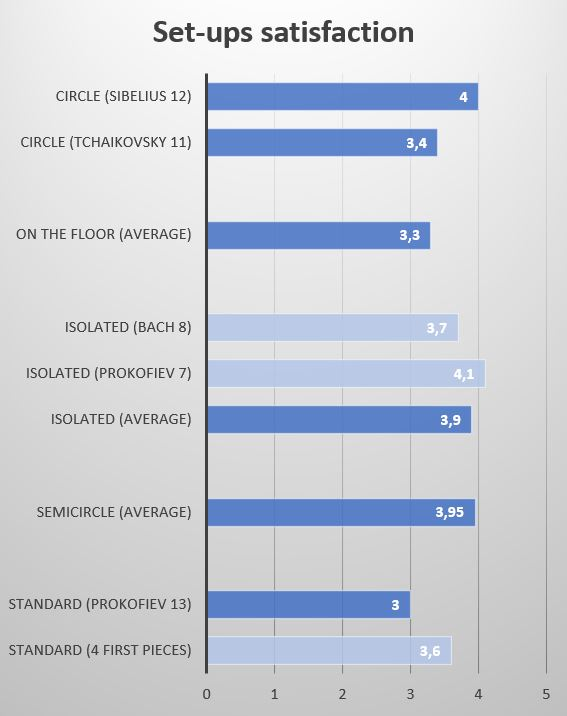(5. C. Results. II)
MUSICIANS SESSIONS: (4) SET-UP(S)
Concerning the different settings tested during the sessions with musicians, the results show that preparing something unconventional could be worth it. Five different set-ups for the audience and the performer were chosen: a standard one, with the public sitting in front of the player at a standard distance, quite symmetric and grouped; a semicircle, with the musician in the middle of the hypothetical full circle; another one with the listeners as distanced and isolated around the hall as possible; another one with the audience sitting on the floor, and the last one with them placed now in a full circle. Each participant could respond if each set-up helped them or not to be engaged by listening to each musical piece from 1 (not helpful) to 5 (definitely profitable).
STANDARD SET-UP. The first four pieces were performed with the standard setting in order to settle into the session, and also the last one, Prokofiev (13), after the whole series of changes. Evidence is that the average of the first four pieces is pretty higher than the last one: 3.6 vs 3. In addition to the fact that at the end of the session listeners could feel the standard set-up as more boring, I believe that it was almost impossible to evaluate correctly the setting of the first performances without having any background and without knowing how the experiments would develop.
SEMICIRCLE AND 'ISOLATED'. For Saariaho (5) and Bach (6) I asked the audience to sit (in chairs) in a semicircle. The reaction was positive: 3.95 of global rating. This score hardly differs for the following setting, the 'isolated' one, with a 3.9 divided by a 4.1 (the highest mark) for Prokofiev's beginning (7) and 3.7 for the fragment in D Major of Bach's Chaconne (8). The eyes-closed hearing to Prokofiev may have slightly increased this difference in reception. What other written feedback also shows is that this set-up benefits the intimacy of musical listening.
SITTING ON THE FLOOR does not seem to be truly helpful, since it scored only 3.3 in both Bartok (9) and Mozart (10). Although I did not calculate the exact standard deviation, looking at the ratings I can say that these two pieces had one of the biggest amounts of 'ones' but also an important quantity of 'fives'. One of my interpretations is that doing something a little more bizarre did not convince several listeners at all, which reduced the final score.
THE CIRCULAR SET-UP was tested in the second versions of Tchaikovsky (11) and Sibelius (12), but in two different ways. In the first piece, in which the circle rated 3.4, I was standing in the middle without moving, therefore, turning my back on part of the public. Nevertheless, in the second I walked like in an inner circle, so I played at least for a while in front of each listener, also closer to him or her this time. This idea was received with a 4.
